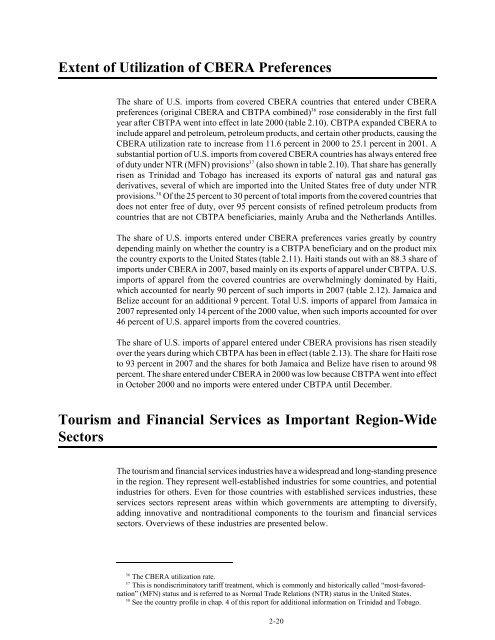Caribbean Region: Review of Economic Growth and ... - USITC
Caribbean Region: Review of Economic Growth and ... - USITC
Caribbean Region: Review of Economic Growth and ... - USITC
You also want an ePaper? Increase the reach of your titles
YUMPU automatically turns print PDFs into web optimized ePapers that Google loves.
Extent <strong>of</strong> Utilization <strong>of</strong> CBERA PreferencesThe share <strong>of</strong> U.S. imports from covered CBERA countries that entered under CBERA36preferences (original CBERA <strong>and</strong> CBTPA combined) rose considerably in the first fullyear after CBTPA went into effect in late 2000 (table 2.10). CBTPA exp<strong>and</strong>ed CBERA toinclude apparel <strong>and</strong> petroleum, petroleum products, <strong>and</strong> certain other products, causing theCBERA utilization rate to increase from 11.6 percent in 2000 to 25.1 percent in 2001. Asubstantial portion <strong>of</strong> U.S. imports from covered CBERA countries has always entered free37<strong>of</strong> duty under NTR (MFN) provisions (also shown in table 2.10). That share has generallyrisen as Trinidad <strong>and</strong> Tobago has increased its exports <strong>of</strong> natural gas <strong>and</strong> natural gasderivatives, several <strong>of</strong> which are imported into the United States free <strong>of</strong> duty under NTR38provisions. Of the 25 percent to 30 percent <strong>of</strong> total imports from the covered countries thatdoes not enter free <strong>of</strong> duty, over 95 percent consists <strong>of</strong> refined petroleum products fromcountries that are not CBTPA beneficiaries, mainly Aruba <strong>and</strong> the Netherl<strong>and</strong>s Antilles.The share <strong>of</strong> U.S. imports entered under CBERA preferences varies greatly by countrydepending mainly on whether the country is a CBTPA beneficiary <strong>and</strong> on the product mixthe country exports to the United States (table 2.11). Haiti st<strong>and</strong>s out with an 88.3 share <strong>of</strong>imports under CBERA in 2007, based mainly on its exports <strong>of</strong> apparel under CBTPA. U.S.imports <strong>of</strong> apparel from the covered countries are overwhelmingly dominated by Haiti,which accounted for nearly 90 percent <strong>of</strong> such imports in 2007 (table 2.12). Jamaica <strong>and</strong>Belize account for an additional 9 percent. Total U.S. imports <strong>of</strong> apparel from Jamaica in2007 represented only 14 percent <strong>of</strong> the 2000 value, when such imports accounted for over46 percent <strong>of</strong> U.S. apparel imports from the covered countries.The share <strong>of</strong> U.S. imports <strong>of</strong> apparel entered under CBERA provisions has risen steadilyover the years during which CBTPA has been in effect (table 2.13). The share for Haiti roseto 93 percent in 2007 <strong>and</strong> the shares for both Jamaica <strong>and</strong> Belize have risen to around 98percent. The share entered under CBERA in 2000 was low because CBTPA went into effectin October 2000 <strong>and</strong> no imports were entered under CBTPA until December.Tourism <strong>and</strong> Financial Services as Important <strong>Region</strong>-WideSectorsThe tourism <strong>and</strong> financial services industries have a widespread <strong>and</strong> long-st<strong>and</strong>ing presencein the region. They represent well-established industries for some countries, <strong>and</strong> potentialindustries for others. Even for those countries with established services industries, theseservices sectors represent areas within which governments are attempting to diversify,adding innovative <strong>and</strong> nontraditional components to the tourism <strong>and</strong> financial servicessectors. Overviews <strong>of</strong> these industries are presented below.36The CBERA utilization rate.37This is nondiscriminatory tariff treatment, which is commonly <strong>and</strong> historically called “most-favorednation”(MFN) status <strong>and</strong> is referred to as Normal Trade Relations (NTR) status in the United States.38See the country pr<strong>of</strong>ile in chap. 4 <strong>of</strong> this report for additional information on Trinidad <strong>and</strong> Tobago.2-20
















